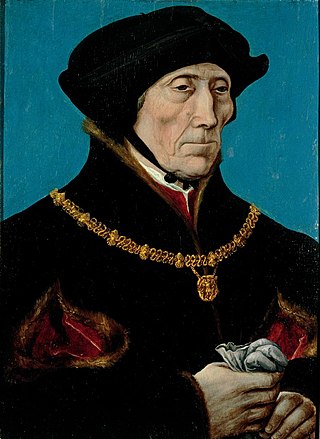
The House of Rohan is a Breton family of viscounts, later dukes and princes in the French nobility, coming from the locality of Rohan in Brittany. Their line descends from the viscounts of Porhoët and is said to trace back to the legendary Conan Meriadoc. Through the Porhoët, the Rohan are related to the Dukes of Brittany, with whom the family intermingled again after its inception. During the Middle Ages, it was one of the most powerful families in the Duchy of Brittany. They developed ties with the French and English royal houses as well, and played an important role in French and European history.

The House of La Trémoïlle(Maison de La Trémoille in French) was a French noble family from Poitou whose name comes from the village La Trimouille in the department of Vienne. This family has been known since the middle of the 11th century, and since the 14th century its members have been conspicuous in French history as nobles, military leaders and crusaders, and influential as political leaders, diplomats, Huguenots and courtiers. The male line of the family died out in 1933, while female line heirs of the last duke have kept the La Trémoïlle surname alive in Belgium.

The House of Montfort-Britanny was a Breton-French noble family, which reigned in the Duchy of Brittany from 1365 to 1514. It was a cadet branch of the House of Dreux; it was thus ultimately part of the Capetian dynasty. It should not be confused with the older House of Montfort which ruled as Counts of Montfort-l'Amaury.
Charlotte of Naples, also known as Charlotte of Aragon and Princess of Taranto, was the eldest daughter and eventual heiress of King Frederick of Naples. Although her father was dispossessed of his kingdom, her descendants, the House of La Trémoïlle maintained their dynastic claim in exile.
Guy XIV de Laval, François de Montfort-Laval,, comte de Laval, baron de Vitré and of La Roche-Bernard, seigneur of Gâvre, of Acquigny, of Tinténiac, of Montfort and Gaël, of Bécherel, was a French nobleman, known for his account of Joan of Arc. He and his brother André de Lohéac were simultaneously vassals of the duke of Brittany and of the king of France.
Guy XIII de Laval, born Jean de Montfort, was seigneur of Laval and of Kergorlay. He was the son of Raoul IX de Montfort and Jeanne de Kergorlay.
Anne de Laval, Princess of Taranto, was a French noblewoman and nominal pretender to the Kingdom of Naples. She was born at Vitré, Ille-et-Vilaine, the daughter of Guy XVI de Laval, count of Laval, and of Charlotte of Aragon, Princess of Taranto.

Anne de Laval was a French noblewoman. She was the ruling Dame/Seigneur de Laval in 1414–1429.
François de La Trémoille, Viscount of Thouars (1505–1541) was a French nobleman of the La Tremoille family. He was the son of Charles I de la Trémoille and of Louise de Coëtivy.

Jeanne de Laval, was the second wife and titular Queen consort of René I of Anjou, King of Naples, Sicily, titular King of Jerusalem, Aragon, and Majorca; Duke of Anjou, Bar, and Lorraine; and Count of Provence and Piedmont.
Charlotte de Laval, Dame de Châtillon, was a French noblewoman from one of the most powerful families in Brittany. She was the first wife of Gaspard de Coligny, Seigneur de Châtillon, Admiral of France and a prominent Huguenot leader during the French Wars of Religion. She was the mother of Louise de Coligny, the fourth wife of William the Silent, Prince of Orange. The present British Royal Family directly descends from her.
Isabella of Brittany was a daughter of John V, Duke of Brittany, and his wife, Joan of Valois. Isabella was a member of the House of Dreux.
Castres-en-Albigenses was a dependence of the Viscount of Albi. The Viscounts of Albi granted Castres a city charter establishing a commune with the city, headed by consuls. During the Albigensian Crusade, the city quickly surrendered to Simon de Montfort, who gave it to his brother Guy de Montfort.

Anne-Adrien-Pierre de Montmorency, 1st Duke of San Fernando Luis, 3rd Duke of Laval-Montmorency, GE, was a peer of France and of Spain.

Guy XVI, Count of Laval, Mayenne was a member of the House of Laval. He was christened Nicolas, but upon inheriting the title, he took the required name of Guy, as his predecessors had done. He was the son of Jean de Laval, who was the brother of Guy XV and the son of Guy XIV and Isabella of Brittany.
Guy IX de Laval was a member of the House of Laval. He was Seigneur de Laval and d'Acquigny, of Beaumont-du-Gâtinais, Viscomte de Rennes, Comte de Caserte in Campania and Baron de Vitré.

Matthew II or Mathieu II, called the Great or the Great Constable, was lord of Montmorency from 1189 and Constable of France from 1218 to 1230.

Guillaume de Montmorency was Baron de Montmorency and lord of Chantilly. As general of finances for the king, he was governor of several royal castles and accompanied Louis XII during the Italian War of 1494–1498.














